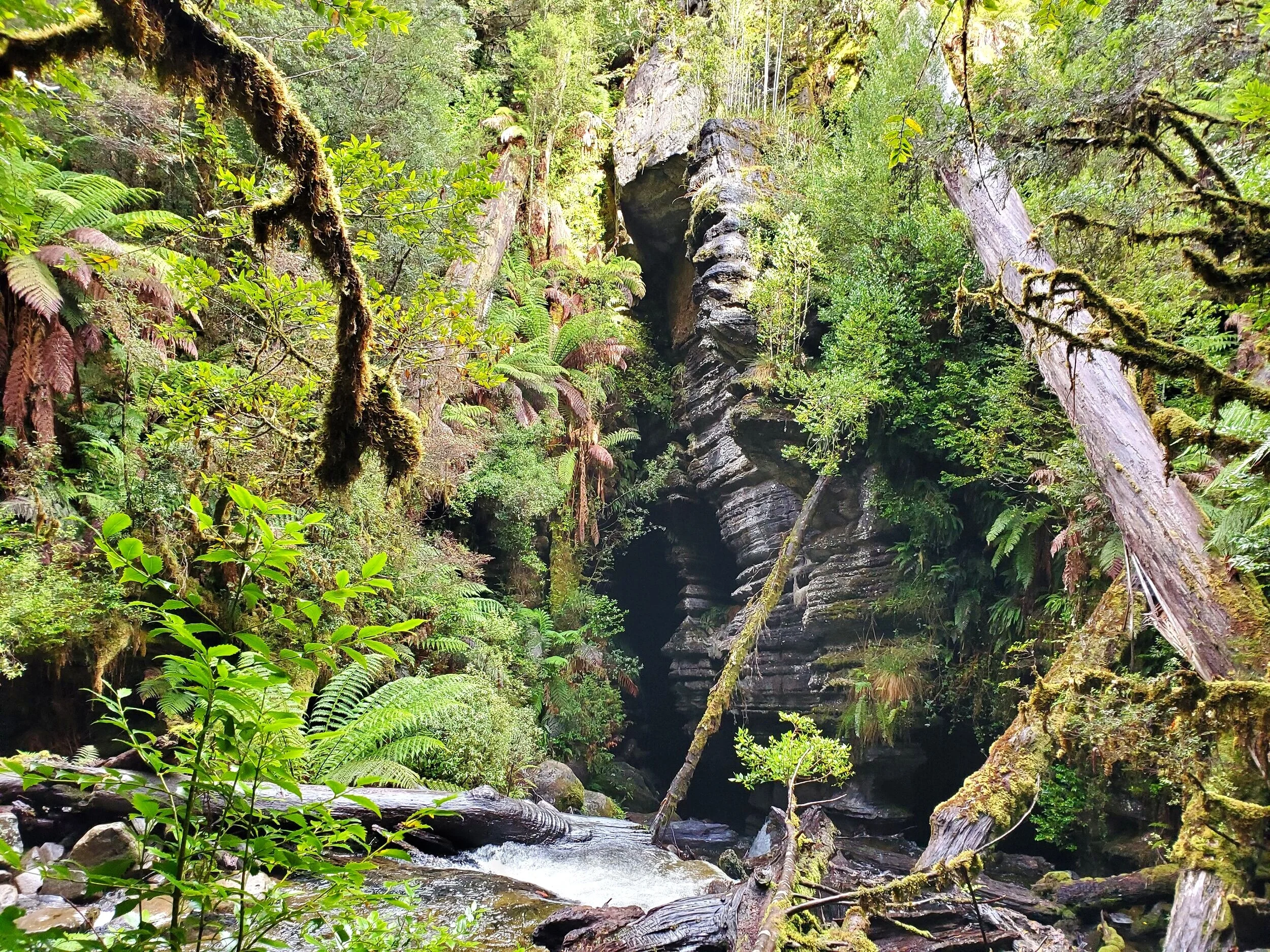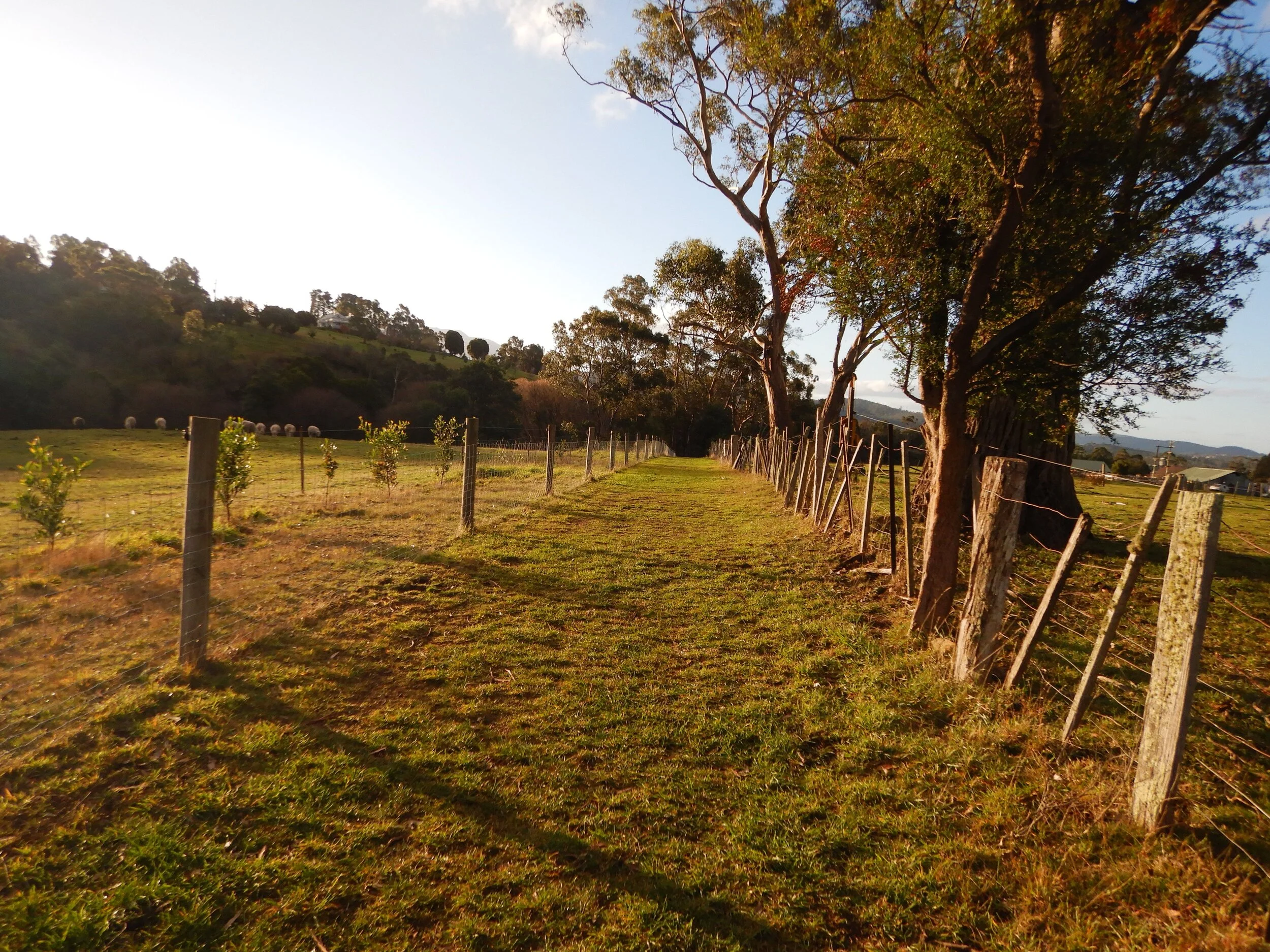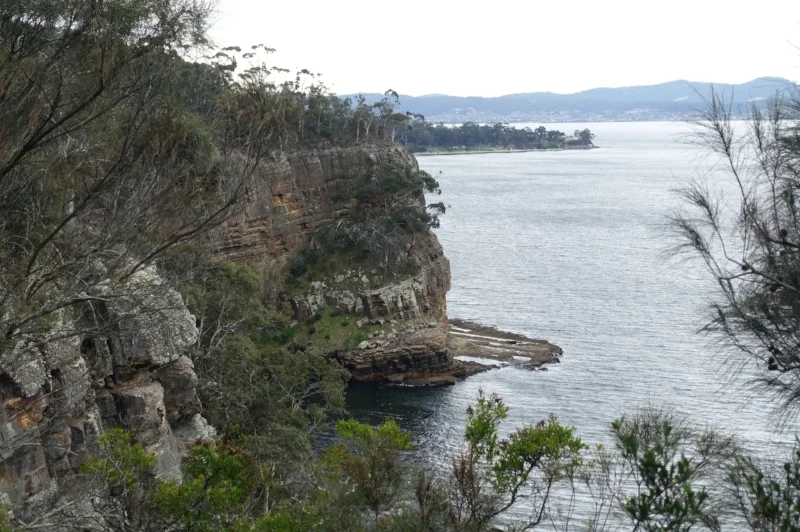Long Walks - Overnight Camping Required
The Mt Rogoona Circuit is a 25km circuit in the southern end of the Walls of Jerusalem National Park, Tasmania. It provides access to a less visited part of this increasingly popular national park. The circuit takes in spectacular views of rugged Mt Rogoona, some beautiful lakes and a couple of historic huts. There are a number of good campsites along the route and it is also a way to access the exotically named Never Never. Here is our experience of the walk.
The Douglas Apsley National Park is on Tasmania’s East Coast, between the towns of St Marys and Bicheno. It gets its name from the park’s two main rivers. The Leeaberra Track runs the length of the park, which contains the largest remaining area of dry sclerophyll forest in Tasmania. It also has rivers, waterfalls, rugged rock formations and a variety of vegetation types.
With friend and long-time walking companion Graeme (who also has a dodgy knee) we decided to tackle the 2.5 day, 28 km walk. Here's our walk report.
The Walls of Jerusalem in Tasmania's Central Highlands is a popular destination for a relatively easy overnight wilderness camping experience.
A wilderness walk to a spectacular pink granite sand lake in South West Tasmania.
Day Walks
Lake Judd is an ancient glacier-formed lake in Tasmania’s Southwest National Park, with a spectacular back-drop of 600 metre high cliffs and views of Mt Anne, SW Tasmania’s highest peak. The 16 km day walk to the lake and back traverses button grass plains peppered with pink quartzite outcrops. As the track ascends the view behind is of Lake Pedder and surrounding peaks. The first 7 kms of the 8 kms to the lake is on part of the renowned, multi-day Mt Anne Circuit Walk. We did the Lake Judd walk in January 2024. Here’s what we found.
Mount Kate is a little visited peak in the Cradle Mountain – Lake St Clair National Park. It is not signposted but is a relatively easy 6 km return walk from Ronny Creek. It provides great views of Cradle Mountain, with a different perspective to most of the walking tracks in the area. It is a very worthwhile day walk. Here’s how we went about it.
Starting from the evocatively named ‘Edge of the World’, at the mouth of the Arthur River on Tasmania’s wild west coast, this beach walk takes you along a stretch of broad, white sand to a rocky point of great significance to Tasmania’s indigenous peoples. It’s an easy half day (4 – 5 hour) walk that gives a good feel for this dramatic, windswept coastline facing the Roaring Forties and the Southern Ocean.
In November 2017 we published a post describing the day walk to the famous southern Tasmanian big wave surfing spot of Shipstern Bluff aka Shippies. Four years on we’ve returned to Shippies to check out the upgrades to the walk that we’d heard had been done. This post describes these changes. The walk itself still takes four hours return following the same track. But there have been some nice improvements to amenities and signage in the intervening years.
Cape Surville is a little visited, but spectacular location on the Forestier Peninsula, on Tasmania’s east coast. A return walk of just under 6 kms features some dramatic high sea cliffs. The access road in is rough in parts and requires a four-wheel drive vehicle. We didn’t have one, but solved this problem by cycling the most difficult section on e-mountain bikes (EMTBs). Here’s how we did it.
Black Glen Falls is a series of five small waterfalls on the Lachlan River in southeast Tasmania. It sits inside Wellington Park, the reserve that covers most of kunanyi/Mt Wellington. The walk to the falls and back is a 4 kilometre return trip. Despite being less than an hour’s drive from home in Hobart I’d never been there before, so with regular walking companion Graeme, we went to check it out.
A “swallet’ is defined as an “underground stream”, also “an opening through which a stream disappears underground”. Tucked away in a corner of Mt Field National Park in Southern Tasmania is Growling Swallet. It is a place where the Junee River disappears underground through a large cave. It is said that when the river is running hard it positively growls. I’d never heard of this place until recently when a friend mentioned it. We decided to check it out. Here’s what we found.
Being the proud owners of Frida, the heeler-border collie cross rescue dog, means that walks in national parks are off the menu when we want to take Frida with us. North East Tasmania doesn’t have a lot of territory classified as national parks, but it does have plenty of good, short walks within reserves and state forests where dogs are permitted. We decided to check out a few of these. Here are four good dog-friendly short walks in the region.
Waratah is a small town in North West Tasmania. The town was built to support a tin mine at nearby Mt Bischoff. It was constructed on top of a waterfall so that the diverted water could be used for mining operations. On my recent first-time visit to Waratah, I was keen to see the town waterfall. While there we took the opportunity to visit two other waterfalls in the area and a couple of other sites of interest.
The township of Richmond is one of Tasmania’s oldest settlements. Richmond was a convict station and military post. It is home to Australia’s oldest bridge built in 1823 by convicts. Just thirty minutes’ drive from the centre of Hobart, Richmond is an excellent day trip for anyone visiting the south of the state. In this post we describe the Richmond Heritage Walk as recommended by Clarence Council which we did recently.
The Clarence Coastal Trail makes it possible to walk from Cremorne to Seven Mile Beach, a distance of around 13.5kms. It is an attractive and satisfying walk. You can leave or join at several places or just do a chosen section. We have broken the walk down into two sections: Cremorne to Roches Beach (this post) and Roches Beach to Seven Mile Beach (previous post).. Read on if you want to know more.
In the southern suburbs of Hobart lies the municipality of Kingborough. Within this region there are an abundance of walking opportunities, including a lot of good short walks. Along with friend Jillian I decided to combine two creek walks which we had not previously done – Nierinna Creek Track and Margate Creek Track. The walk notes and maps on the council web page showed how these two walks could be easily joined into one longer walk.
The Hobart Rivulet was critically important to 19th century colonial Hobart both as it’s water supply and for a number of industrial purposes. Today the 2.7 km walk beside the rivulet which wends through the suburb of South Hobart provides many insights into the city’s past. It also affords excellent views of kunanyi/Mt Wellington before concluding at the Cascade Brewery, Australia’s oldest brewery, established 1824.
Kelly Basin is on the south east side of Macquarie Harbour on Tasmania’s west coast. The towns of East and West Pillinger once stood on Kelly Basin and had a population of over 1000. East Pillinger was established as a port for the North Mount Lyell Mining Company’s rail line which ran from Queenstown bringing copper to be exported.. The town was abandoned in 1924 after the rival Mount Lyell Mining Company took over North Mount Lyell Mining. Today there are still remnants of the port town of East Pillinger to be explored. This includes brick kilns, parts of buildings, giant metal boilers and the old wharf. We wanted to see for ourselves so headed off from Queenstown to do the half day walk.
The term Tarkine or takayna, its Aboriginal name, is used to describe much of north west Tasmania. It is a region of rainforests and rivers, imposing mountains and wild coastlines. It is currently unprotected. There are ongoing efforts by many people to have this remedied to protect the area for future generations. With regular walking companion Graeme, we chose two walks in the southern part of the Tarkine – the Huskisson River Rainforest Walk and Mt Murchison, one of the west’s highest peaks.
Many visitors to the Tasman Peninsula, on their way to the Port Arthur Historic Site, make a brief stopover at the Tessellated Pavement State Reserve at Eaglehawk Neck. They come to admire the unusual, geometric patterns in the coastal rock platform. From the Tessellated Pavement the view to the north features a small island adjacent to the shore. This is Clydes Island. Few bother to make the leisurely one kilometre walk along the beach and rocky shoreline to the island. We decided to have a closer look at Clydes Island and then to venture along the cliff-top trail that we’d heard continues beyond.
The Needles are a group of rocky spires that protrude from the landscape of south west Tasmania. The 2 – 3 hour return walk to the top-most Needle (1020m) takes you up a steepish trail with spectacular views unfolding as you ascend. From the top you have a 360 degree panorama of the SW Wilderness World Heritage Area. On a clear day this has to be one of Tassie’s most spectacular short wilderness walks.
When you book the Three Capes Track 4 day walk, in SE Tasmania, you are actually only getting two capes for your money – Cape Pillar and Cape Hauy. This isn’t to say that it isn’t a fabulous experience – it is. The trail takes you along some of Australia’s most spectacular coast and cliffs. But if you want your full complement of capes then you need do a separate additional day walk to nearby Cape Raoul. This post describes our recent visit to Cape Raoul, our first since new track work was done.
�
Tasmania is full of places and attractions that don’t feature prominently in the tourist literature. In fact, some are so obscure that many locals don’t even know about them. This post describes a day walk we did to little known Bluff Canyon. In the spirit of Secret Tasmania, we don’t give too much detail about where and how to do the walk. There are no maps here. If you’re interested, you might need to do a bit of extra research.
The Monk Bay Circuit Walk is a 8.3km coastal walk within the Lime Bay State Reserve, Tasman Peninsula in south east Tasmania. It’s an easy 3 – 3.5 hour walk with constant views of the surrounding waterways.
The Tasman Peninsula is also home to the Port Arthur Historic Site, Australia’s premier colonial convict site. Close to Port Arthur are the remains of a large convict probation station established for the purposes of coal mining. Today there are well preserved ruins with good interpretative signs. The Historic Coal Mines site can easily be combined with the Monk Bay walk making for a varied and interesting day trip from Hobart. And it’s all free.
This post covers a walk in the south eastern end of Tasman National Park and involves part of the Three Capes Track. It is a long day walk taking in Mt Fortescue and, potentially, Cape Hauy before returning to the starting point at Fortescue Bay.
Arthurs Peak is in the Tasman National Park in Tasmania and is on the route of the recently opened and popular Three Capes Walk - a multi-day fee paying walk. Since the advent of the Three Capes Walk we were unclear as to whether it was still possible to walk to Arthurs Peak via an old track. We also wanted to clarify what the options were for overnight walking in the park for self-sufficient campers who were not paying to stay in the designated huts that are exclusively for paying walkers. This post sets out to provide answers these questions and describe the day walk we succeeded in doing to Arthurs Peak.
The Roches Beach to Seven Mile Beach track is an easy, pleasant, short coastal walk with spectacular views. Located 22km east of Central Hobart, it is a 20 minute drive from town. The walk is 3.3km one way. You can start the walk from either end. If you want a longer walk you can start or finish at Lauderdale Canal rather than Roches, a total of 6km.
In November 2017 we published a post describing the day walk to the famous southern Tasmanian big wave surfing spot of Shipstern Bluff aka Shippies. Four years on we’ve returned to Shippies to check out the upgrades to the walk that we’d heard had been done. This post describes these changes. The walk itself still takes four hours return following the same track. But there have been some nice improvements to amenities and signage in the intervening years.
It was a lazy, early spring Sunday morning and we wanted to get a bit of exercise. We settled on the Alum Cliffs track, which begins near Kingston Beach in Hobart’s southern suburbs. This is a 6 km return coastal walk with some good views of the river and cliffs. The starting point is Tyndall Beach, which is a dog-friendly beach on the northern side of Browns Rivulet across from Kingston Beach. Here is our report on the walk.
The Cape Hauy walk has some of the most spectacular coastal views in Australia and it can be done as a day trip from Hobart.
An easy, pleasant walk through forest and button grass to a delightful lake with stunning views of Western Tasmania.


















































































Lake St. Clair is at the southern end of Cradle Mountain – Lake St. Clair National Park. The car park and visitors centre are at Cynthia Bay. This is also the end point for people completing the Overland Track from north to south. From here there are a number of good day walks as well as longer walks. We decided to head out there for a long weekend, with a good weather forecast, to do a bit of exploring, including a walk and camping at Shadow Lake and to do the Mt Rufus Circuit.